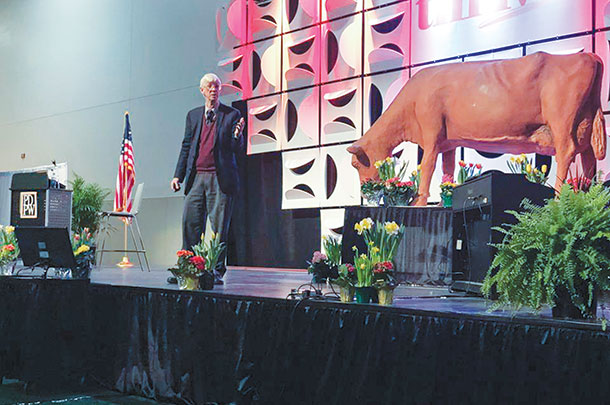“Dairying to Thrive” was the theme for the 26th annual Professional Dairy Producers 2018 Business Conference, held March 14-15 in Madison, Wisconsin.
Farmers and allied industry gathered to hear from a world-class lineup of more than 40 speakers to share insights in keynote sessions, breakout sessions, specialty sessions and hands-on workshops. From the Chinese dairy industry to world markets, the future of dairy prices took center stage.
Other sessions left standing room only as producers packed in to learn about everything from data management to dairy futures and calf care to emergency response.
The conference not only sought to educate but also to inspire. Motivational speakers did just that. Burn survivor John O’Leary told his story of overcoming his situation with energy and attitude, while Liz Murray shared the determination she used to go from homeless to a Harvard University scholarship. Former Wisconsin Badger and Green Bay Packer offensive tackle Mark Tauscher served as the emcee and evening keynote for the conference.
A few key take-aways from the conference are noted below.
Managing through turbulent times

Michael Boehlje, ag economics professor with Purdue University, provided a list of 10 key principles when managing a farm business through turbulent times. They included:
- Create value for your customer to provide a sustainable competitive advantage.
- Focus on strategy that emphasizes operational excellence, includes understanding your customer, provides innovative products and enhances the links in the value chain.
- Maximize asset utilization by using leases, sharing machinery, outsourcing some custom operations and spreading capital investments over longer periods of time.
- Increase margins by controlling costs, using best management practices and using marketing tools.
- Grow volume and sales by increasing productivity without adding costs.
- Use capital wisely, using debt carefully, leasing versus buying when possible and enhancing financial skills.
-
 Use time efficiently, focusing on management while empowering skilled employees, developing workflow plans and developing standard operating procedures.
Use time efficiently, focusing on management while empowering skilled employees, developing workflow plans and developing standard operating procedures.
- Identify and manage operating and strategic risks.
- “Get smart” by using consultants; network with farm and nonfarm managers, developing management skills and improving data analytics.
- Think like a chief executive officer, managing people, money, relationships and strategies.
The bottom line, Boehlje said, “is that it’s difficult to accurately predict the future, so position yourself for both challenges and opportunities.”
‘Get a grip and move beyond the dip’

Daniel Basse, president of AgResource Company, identified political and economic factors impacting agriculture in 2018. Both, he said, were more “disorderly” compared to the past decade. That disorder, he explained, included President Trump’s stance on global trade and its impact on U.S. agriculture.
Basse said he’s less bearish on dairy but not necessarily bullish, with milk prices having likely bottomed out and beginning to rebound. The best chances for higher prices will come in the fourth quarter of 2018. However, feed costs face more upside risk due to weather, so 2018 feed costs could be 10 to 15 percent higher than 2017.
Among dairy commodities, butter will continue to outshine milk powders even if powder demand from China grows. Dairy exports will continue to depend on the strength of the U.S. dollar in relation to other currencies.
U.S. farmers must continue to focus on reducing costs and protecting margin.
Get the ‘dairy’ scoop on China
In a breakout session focused on China’s dairy industry, a brief overview of the country’s dairy status was provided, along with a business model putting dairy products in front of consumers.
China currently has 13 million dairy cows and is producing 6 percent of the world’s milk. Scaled dairy farms with freestall barns and milking parlors are averaging 18,500 pounds of milk per cow a year, with several farms producing upward of 26,500 pounds per cow per year.
Zhijun Cao, associate professor and assistant dean, China Agricultural University’s College of Animal Science and Technology, said the milk price in China is 30 to 40 percent higher than other developed countries, but feed costs are 30 to 50 percent higher – and over the last two years, more than half of the dairy producers in China are struggling to be profitable.
With the high domestic price, some plants are choosing to import milk powder instead of utilizing the products produced in China.
Opportunities the industry needs to grow include building confidence and lowering the price for processors, cultivating a relationship between farmers and processors, and nurturing the next generation to gain an interest in dairy.
While it may not be an interest on the production side of dairy, Zhu Li Ke, CEO and general manager of China Zhejiang YiMing Food Company Ltd., is developing a generation of people interested in consuming dairy products. Li Ke and his father consider milk and eggs to be the most nutritious food products, so they created a breakfast revolution.
A traditional Chinese breakfast consisted of porridge, fried dough sticks and pickles. The healthier breakfast they introduced was coined “Four Ones,” with one egg, one milk, one bread and one apple.
With a generation of people raised on milk and eggs for breakfast, Li Ke has a strong customer base for the 1,200 milk bars he operates in southeast China and Shanghai. These storefronts, which offer breakfast foods and dairy products from China and around the world, can be found in neighborhoods, college campuses and metropolitan city centers. They are the end of his vertically integrated business that includes farm production and processing.
In addition to producing milk on the company farm, Li Ke purchased milk from 6,000 farmers last year. He is also traveling around the world to not only sample cheeses to determine which ones will fit within his consumers’ preference but to visit the farms and verify the source of the dairy products he is purchasing.
With a per-capita dairy consumption that pales in comparison to other developed countries, Li Ke sees huge opportunity in supplying dairy products to consumers in China.
Milk marketing and risk management
Two Wisconsin dairy farmers, Jay Binversie of Robinway Dairy Farms LLC, Kiel; and Steve Schalla of Bomaz Farms, Hammond, shared experiences using dairy futures and options in milk marketing and risk management. The panel was moderated by Carl Babler, a broker with Atten Babler Risk Management.
Schalla and Binversie rely little on federal dairy safety net programs for risk management. While hopeful changes in the Margin Protection Program for Dairy (MPP-Dairy) will make the program better, they prefer to maintain personal control of risk management through marketing.
Schalla spent time as an intern and dairy market adviser with Stewart-Peterson Group prior to joining the family farm, where he now serves as risk and business manager. He utilizes flexible strategies, using options to put himself in the best position “to be wrong.”
“One of the biggest rewards hedging has allowed us to do is achieve the financial stability we want and pursue some of our other goals,” he said. Schalla identified the biggest challenges to marketing as finding the time, developing the knowledge and implementing the discipline.
Binversie said he became interested in hedging in the 1990s at a time when his farm equity was low. He termed his first experience with hedging as “unsuccessful” after milk prices rose sharply after he hedged milk, losing on upside potential. After pursuing additional education, he learned marketing discipline, like discipline in all areas of dairy management, was important with long-term plans and goals in mind.
Binversie urged producers to start with a business plan, identifying the risks to that plan, working with a broker you’re comfortable with and balancing risks by spreading out contracts.
Babler said dairy producers using hedging often make the biggest mistakes at the “top” and “bottom” of markets. He also said farmers avoid contracting out of fear they’ll miss out on price opportunity. He recommended consistency in participation and planning when implementing a marketing strategy.
Rising labor costs: Strategies and approaches
Labor costs are becoming a larger share of overall farm costs, with growing labor needs as farms get larger, increasing competition for available labor and higher wages either through regulation or competition.
Jason Karszes, senior extension associate with Cornell University’s PRO-DAIRY program, provided economic analysis of 138 New York dairy farms. He estimated 2017 labor costs would be up 5 to 6 percent from 2016.
Karzses urged farmers to analyze how labor is utilized, including identifying hours spent in various production categories and areas providing the greatest opportunity for labor efficiency improvement.
Labor effectiveness can be enhanced through reducing mistakes and distractions, keeping equipment and facilities in good repair and easily accessible, maintaining daily routines and decreasing waste.
He urged producers to make sure any capital investment is offset by labor savings. If labor does a better job generating profit, it may make the farm able to pay higher wages and remain competitive for available labor.
Board elections
Janet Clark of Eldorado, Wisconsin, was elected to a three-year term during the group’s annual business conference. Re-elected to the board were incumbent directors Jay Heeg of Colby, Wisconsin, and Dan Scheider of Freeport, Illinois. ![]()
PHOTO 1: Providing insight on the dairy industry in China were, left to right, Zhijun Cao, Zhu Li Ke and Jennifer Lu, international economic development consultant for Wisconsin Department of Agriculture, Trade and Consumer Protection. Photo by Karen Lee.
PHOTO 2: Among his tips for thriving during turbulent times, Mike Boehlje said to focus on a strategy that emphasizes operational excellence, including understanding your customer; provides innovative products; and enhances the links in the value chain.
PHOTO 3: Dan Basse predicted higher dairy prices in the fourth quarter of 2018. Photos by Joey Opsal Photography.



